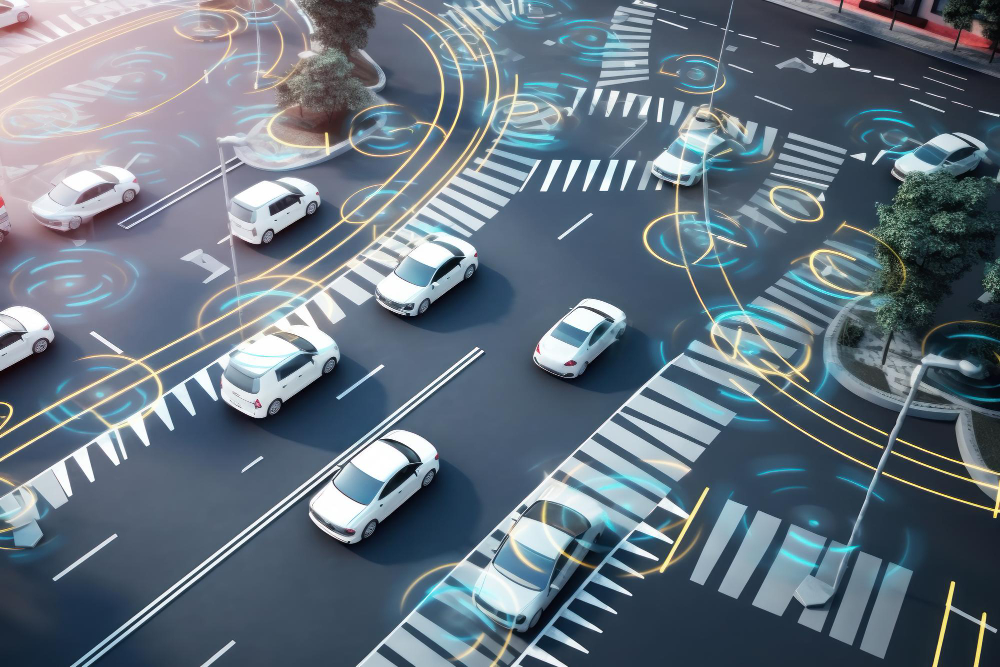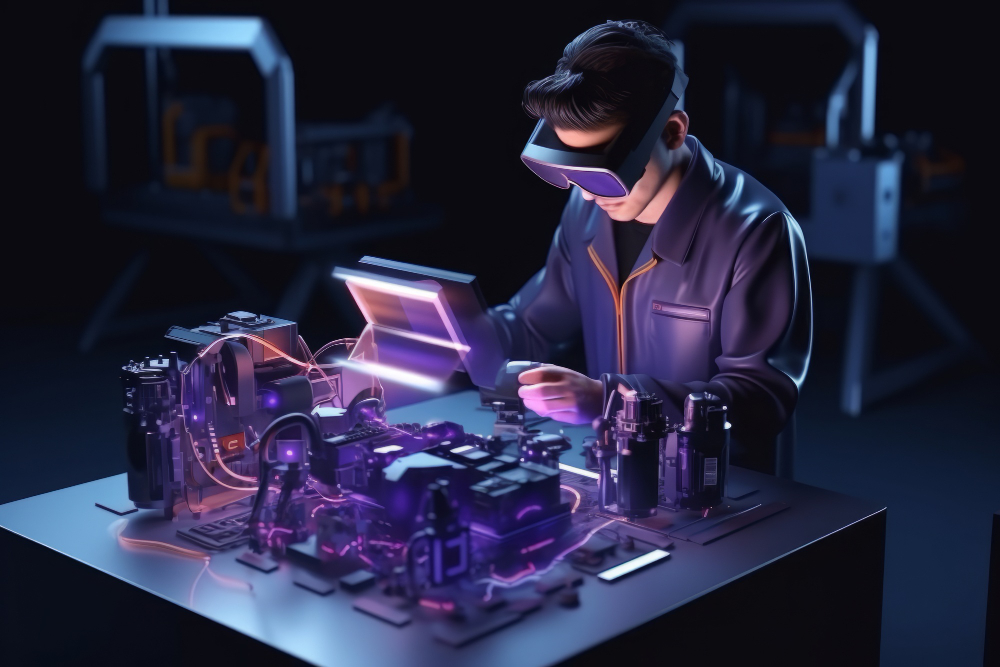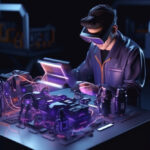Autonomous Vehicles- Real-world Examples of Vision Analytics

The development of self-driving cars is one of the most trendy inventions in AI and machine learning.
Autonomous vehicles, often referred to as self-driving cars, are no longer a future vision. They’re here right now, and they’re going to change the way we commute and live. For safe and effective navigation through the actual world, these vehicles combine several cutting-edge technologies, such as computer vision, machine learning, and artificial general intelligence (AGI).
A more than 50% rise from 2020 was seen in funding for autonomous vehicle (AV) businesses in 2021, according to CB Insights, and that’s just the beginning. According to Deloitte, 12% of all new cars registered worldwide by 2030 are expected to be autonomous vehicles.
In this blog, we’ll explore the fascinating world of autonomous vehicles and examine real-world examples of how vision analytics plays a critical role in making them a reality.
What exactly is computer vision?
Computer vision is the study of object detection and external environment analysis (traffic signs, lane markings, etc) using specialized cameras. It was previously unthinkable to use computer vision in the car industry. Artificial intelligence, a potent new pillar of information technology, now underpins it.
There are several uses for computer vision, including the identification and reading of license plates for automobiles, as well as the recognition of people, animals, and objects as well as the understanding of obstacles, road signs, and traffic signals. Because there are actual lives at stake and even the smallest error must be prevented, this application is incredibly important.
How Do Autonomous Vehicles Work?
The autonomous car industry is based on computer vision. To properly navigate the road, cars use object identification algorithms in conjunction with cutting-edge cameras and sensors to assess their surroundings in real-time and identify objects like people, road signs, barriers, and other vehicles. Vehicle cameras and vision AI have advanced quickly, bringing them closer than ever to achieving commercial availability, public acceptability, and safety regulations.
The Rise of Autonomous Vehicles
The concept of self-driving vehicles has been a part of science fiction and automotive fantasies for decades. However, recent advancements in technology, including breakthroughs in machine learning and sensor technology, have brought us closer to the realization of autonomous vehicles. These cars can operate without human intervention, relying on complex algorithms and sensors to make real-time decisions about how to navigate the road safely.
Companies like Cruise and TuSimple are actively contributing to the development of these self-driving cars. Cruise, for instance, focuses on creating autonomous vehicle technology with an emphasis on safety and reliability while TuSimple specializes in autonomous trucking, utilizing advanced vision systems to navigate through complex road conditions.
The promise of autonomous vehicles is alluring. They have the potential to reduce traffic accidents, ease traffic congestion, and make transportation more efficient and convenient. But how do these vehicles “see” and understand the world around them? The answer lies in vision analytics.
Vision Analytics: The Eyes of Autonomous Vehicles
Vision analytics is the process of using computer vision to analyze and interpret the visual information captured by cameras and sensors on autonomous vehicles. Just as our eyes are essential for us to understand and navigate the world, cameras, and sensors are the eyes of self-driving cars. These sensors capture images, video, and depth data, which are then processed by sophisticated algorithms to detect and understand the vehicle’s surroundings.
Here are some key components of vision analytics in autonomous vehicles:
-
Cameras:
Cameras are essential visual sensors that capture images and videos of the environment. For object recognition, lane detection, and traffic sign recognition, they offer extensive color and texture information. Based on their outward appearance, cameras can recognize a variety of items, including moving vehicles, pedestrians, traffic signs, and lane markers. Example: A pedestrian crossing the street at an intersection is seen by the front-facing camera.
-
LiDAR (Light Detection and Ranging):
LiDAR sensors use laser pulses to measure the distance between the vehicle and objects in its environment. This technology helps create a 3D point cloud that provides detailed information about the surroundings. It’s particularly useful for identifying obstacles and determining their distance from the vehicle.
-
Radar:
Radio waves are used by radar sensors to identify objects and their speed. Radar is great for seeing moving things like other cars or people, but it is less precise than LiDAR. Radars are especially helpful when it’s raining or foggy outside when cameras could struggle to function properly.
-
Ultrasonic Sensors:
Ultrasonic sensors are used for close-range object detection, particularly during parking and low-speed maneuvers. They emit sound waves and measure the time it takes for the waves to bounce back, allowing the vehicle to detect nearby obstacles.
-
GPS and IMU:
Global Positioning System (GPS) and Inertial Measurement Units (IMU) provide information about the vehicle’s location, orientation, and movement. These data sources are essential for route planning and navigation.
Real-World Examples of Vision Analytics in Autonomous Vehicles
Now that we have a basic understanding of vision analytics and the sensors involved, let’s explore some real-world examples of how these technologies are used in autonomous vehicles.
-
Tesla’s Autopilot:
Tesla is perhaps one of the most recognizable names in the world of autonomous vehicles. Their Autopilot system relies heavily on vision analytics through a combination of cameras and radar sensors. Tesla’s vehicles are equipped with multiple cameras placed around the car, providing a 360-degree view of the surroundings. These cameras can detect and track other vehicles, lane markings, traffic signals, and even pedestrians. The data from these cameras is continuously analyzed by powerful onboard computers to make real-time driving decisions, such as lane-keeping, adaptive cruise control, and even automatic lane changes.
-
Waymo’s Self-Driving Minivans:
Waymo, a subsidiary of Alphabet Inc., has been at the forefront of autonomous vehicle development. Their self-driving minivans are equipped with a combination of cameras, LiDAR, and radar sensors. Waymo’s vehicles use a high-definition mapping system, and their vision analytics software is specifically trained to recognize and distinguish between different types of objects, including pedestrians, cyclists, and vehicles.
-
Uber’s Self-Driving Technology:
Uber, the ride-sharing giant, has also invested heavily in autonomous vehicle technology. They have developed self-driving cars equipped with a combination of cameras and LiDAR sensors. Uber’s autonomous vehicles rely on vision analytics to navigate city streets, pick up passengers, and drop them off safely.
-
General Motors’ Cruise Automation:
General Motors’ Cruise Automation has developed an autonomous driving system, which they’ve tested extensively on the streets of San Francisco. Their vehicles are packed with cameras, LiDAR, radar, and other sensors to capture a comprehensive view of the environment. Vision analytics plays a vital role in identifying and tracking objects, predicting their movements, and making real-time decisions for safe navigation.
-
Baidu’s Apollo Program:
China’s tech giant, Baidu, is also making significant strides in the field of autonomous vehicles with their Apollo program. Baidu’s self-driving cars employ a variety of sensors, including LiDAR and cameras, to capture and interpret visual data. The vehicles use vision analytics to recognize and understand the surrounding environment, making autonomous driving possible.
Challenges and Future Prospects
While the use of vision analytics in autonomous vehicles has come a long way, there are still several challenges to overcome. Some of the key challenges include:
-
Adverse Weather Conditions:
Vision-based systems can struggle in adverse weather conditions, such as heavy rain, snow, or fog, where visibility is reduced. Autonomous vehicles must become more reliable in such situations.
-
Cybersecurity:
The data collected by sensors and cameras are valuable and vulnerable to cyberattacks. Ensuring the security of autonomous vehicle systems is crucial to prevent potential threats.
-
Edge Case Scenarios:
Autonomous vehicles must be prepared for rare and unexpected scenarios, often referred to as “edge cases.” Vision analytics systems need to continually improve their ability to recognize and respond to these unusual situations.
-
Ethical and Legal Considerations:
As autonomous vehicles become more common, there will be a need to address ethical and legal questions, such as liability in the event of accidents and how these vehicles make moral decisions.
Despite these challenges, autonomous car technology appears to have a bright future. As technology continues to advance, we can expect vision analytics to play an even more significant role in the development of self-driving cars. The potential benefits, such as reduced traffic accidents, decreased traffic congestion, and improved mobility for people with disabilities, make the continued development of autonomous vehicles a compelling endeavor.
.
Wrapping It Up
Autonomous vehicles are no longer confined to science fiction novels or distant dreams. They are a reality, and vision analytics is at the heart of their operation. The combination of cameras, LiDAR, radar, and other sensors, along with powerful machine learning algorithms, empowers these vehicles to perceive, interpret, and navigate the real world.
While there are challenges to overcome, the promise of safer roads, reduced traffic congestion, and increased mobility for all is driving the continued development of self-driving cars. Making Autonomous vehicles and adopting Artificial Intelligence is an integral part of our daily lives. As the industry advances, we can expect more exciting developments and innovations in the world of autonomous vehicles.

The Financial Side of Moving: Budgeting and Saving Tips

Making Memories: International Rakhi Celebrations and Traditions

What Makes the #1 Ranked Email Data Service Essential for Your Business?

Pre-Requisites Before Applying for an Instant Personal Loan

Embrace the Magic of Turkey: An Unforgettable Visit

10 Ways To Secure Your Job From AI

The Business Benefits of AI-Powered Calling Systems

The Techno Tricks: Unleashing the Power of Technology








